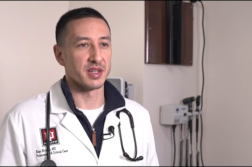CLEVELAND, Ohio. (Ivanhoe Newswire) — When breathing is hard, life is hard. Every single move becomes difficult. Patients with serious breathing disorders sometimes need stents to keep their airways open. Until now, these devices were made with a one-size-fits-all approach. But custom stents are helping some people breathe easier.
A rare condition known as GPA affected Dan Pyles’ breathing and his ability to be an active grandparent.
“I really enjoy my grandkids, but I couldn’t play with them. I couldn’t do anything with them,” Pyles told Ivanhoe.
Scar tissue built up around Pyles’ airways, so getting a good breath was hard.
“It affects absolutely every aspect of what you do,” detailed Pyles.
Pyles was one of the first patients to receive a brand new type of device. Doctors at the Cleveland Clinic designed a custom stent to put inside Pyles’ airway and keep it open. It’s made from a 3D printer.
Tom Gildea, MD, a pulmonary medicine specialist at the Cleveland Clinic described, “With the use of CT scanning and 3D technology, I can design a stent specifically for the patient that I’m treating.” (Read Full Interview)
Standard stents come in a limited number of sizes and shapes. They’re made for large airways and don’t always fit well. The custom stents are designed to fit the exact size and shape of the patient’s airway, big or small. When they’re put in, patients find relief right away.
“Almost instantaneously. Patients immediately feel better with their breathing,” said Dr. Gildea.
Pyles had a custom stent on his left side. It’s allowed him to be more active.
“I get down and play with my grandkids on the floor now,” said Pyles.
He can also breathe easier.
“It’s hard to describe when you struggle for every breath you take, when you finally get a breath that isn’t work, it’s wow. It’s great,” described Pyles.
These stents can be used for a variety of serious breathing disorders, including those caused by a tumor, a mass or inflammation. The customized stents are not yet FDA approved. Clinical trials are expected to start soon. Doctors at the Cleveland Clinic have consent from the FDA to implant the stents on a “compassionate use” basis.
Pyles is planning on having a customized stent placed on his right side as well.
Contributors to this news report include: Cyndy McGrath, Supervising Producer; Julie Marks, Field Producer; Milvionne Chery, Assistant Producer; Tony D’Astoli, Editor.
MEDICAL BREAKTHROUGHS – RESEARCH SUMMARY
TOPIC: Custom Stents Help People Breathe
REPORT: MB #4145
BACKGROUND: Self expandable metallic stents should be reserved for the malignant airway disorder known as Granulomatosis with polyangiitis (GPA). GPA is a rare blood vessel disease that is complex and also potentially serious. Fortunately, with prompt diagnosis this disease can be treated adequately. In GPA, organ damage occurs as a result of inflammation in vasculitis involving both the small and medium sized blood vessels. GPA mainly affects the lungs, sinuses, and kidneys but it can also affect the eyes, ears, skin, joints and other organs in the body. There are many organs involved with the progression of this disease, so a variety of symptoms can develop over days to months. For 90 percent of the affected patients, symptoms show first in the respiratory tract, including nasal congestion, frequent nosebleeds, shortness of breath, and coughing that produced bloody phlegm. Other symptoms include joint pain, decreased hearing, skin rashes, vision changes, appetite/weight loss, night sweats, and feeling of numbness/loss of movement in the toes, fingers, or limbs. GPA is a rare disease that affects 3 out of every 100,000 people. It affects both men and women equally.
(Source: http://www.rheumatology.org/I-Am-A/Patient-Caregiver/Diseases-Conditions/Granulomatosis-with-Polyangitis-Wegners)
DIAGNOSIS: There are many different ways to detect when there is a problem for a patient suffering from GPA. Physical examinations, laboratory testing and imaging studies such as x-rays, CT scans and MRI’s are some diagnostic methods used to determine GPA. Most physicians will recommend a biopsy of the tissues involved to look under the microscope for any signs of characteristic changes. Many people who have GPA also test positive for the presence of proteins in their blood known as antineutrophil cytoplasmic antibodies (ANCA). A blood test that comes out positive for the presence of ANCA supports the need for further examination for GPA. In rare instances, a positive test may provide enough evidence to make a diagnosis of GPA..
(Source: http://www.vasculitisfoundation.org/education/forms/granulomatosis-with-polyangiitis-gpa-wegeners/ )
TREATMENT: Active GPA that involves a major organ site must be treated quickly. It can be dangerous if it is left untreated because of the internal inflammation which can result in organ failure. Treatment options depend on the organs affected, the severity of the disease and other individual medical factors. Patients with a severe case of GPA are often given various types of medications. One is a steroid medication known as glucocorticoid which is a combination of as prednisone and with cyclophosphamide (Cytoxan); a chemotherapy type drug. Prednisone is given to the patient at a high dose which is eventually lowered and the Cytoxan drug is given for 3 to 6 months. The patients who improve are then switched to another form of medication known as methotrexate or azathioprine for 2 years or more. Another form of treatment for severe GPA is rituximab (Rituxan) combined with glucocorticoids. Those patients with active but not severe form of GPA may be treated with prednisone and methotrexate. Each medication has different side effects that must be considered to minimize or prevent the risk of serious side effects.
(Source: http://www.vasculitisfoundation.org/education/forms/granulomatosis-with-polyangiitis-gpa-wegeners/)
FOR MORE INFORMATION ON THIS REPORT, PLEASE CONTACT:
Andrea Pacetti
Cleveland Clinic
If this story or any other Ivanhoe story has impacted your life or prompted you or someone you know to seek or change treatments, please let us know by contacting Marjorie Bekaert Thomas at mthomas@ivanhoe.com




